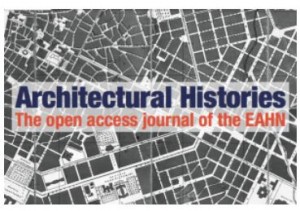 L’EAHN (European Architectural History Network) est à la recherche d’un rédacteur en chef pour sa revue « Architectural Histories ».
L’EAHN (European Architectural History Network) est à la recherche d’un rédacteur en chef pour sa revue « Architectural Histories ».
Applications open for Editor-in-Chief and Editorial Assistant, Architectural Histories. The online open access journal of the EAHN
Architectural Histories is the international, blind peer-reviewed, open access scholarly journal of the European Architectural History Network that creates a space where historically grounded research into all aspects of architecture and the built environment can be made public, consulted, and discussed. The journal is open to historical, historiographical, theoretical, and critical contributions that engage with architecture and the built environment from a historical perspective.
Since the publication of the first article on 30 January 2013, Architectural Histories has published 81 articles (research articles, position papers, editorials, interviews and reviews). These publications were gathered in four open issues and three special collections. Since its start in 2013 the journal has established a growing and balanced readership. In March 2016 alone, the journal could note 7282 page views from 111 different countries worldwide.
The journal is now seeking to appoint a new editor-in-chief and editorial assistant from 1 June 2017 for a four-year term. The new appointees will start working with the current team from 1 January 2017 and gradually take over their duties.
Tasks and duties
The editor-in-chief is responsible for all aspects of the journal. The editorial assistant supports the editor in these tasks, according to their mutual arrangement.
The editor is responsible for the profile and identity of the journal, and safeguards the quality, relevance and scholarly rigor of the journal’s content. Architectural Histories is edited by an international editorial board over which the editor presides.
The editor apportions editorial duties to board-members and follows up on their execution. S/he is primary contact person between authors, reviewers and the journal, and makes the final decisions regarding articles in all stages of submission, review, editing and production, always in close concert with the editorial board.
The editor steers the editorial board in all its tasks: editorial duties, prospection for content, setting up special collections, processing articles, and so forth.
The editor manages the coordination between the different parties involved in the production of the journal: besides the authors and peer reviewers; the publisher, Ubiquity Press; the copy-editor; and the proofreader. The editor is the main contact between the journal and the publisher regarding all aspects of their collaboration, including process management, contract negotiations and payments.
The editor manages the finances of the journal, and actively seeks to broaden and sustain the financial basis for the journal by reaching out to the appropriate organizations and institutions.
S/he is aware of the principles of open access publishing and participates in the debates surrounding it.
The editor is the main contact between the journal and its parent organization, the European Architectural History Network. As such, the editor sits ex officio on the EAHN board.
The editor chairs the editorial board meeting during the annual EAHN business meetings and at the biannual EAHN-conferences.
The position of editor or editorial assistant is not remunerated and expenses are not covered. The editor’s average workload is 4 to 8 hours per week; the average workload of the assistant is 4 hours per week; both are subject to fluctuation.
Qualifications
The editor-in-chief should have a Ph.D. in architectural history (whether from an art history department or a school of architecture). The candidate should be an established scholar who is able to bring a broad personal network of international academic contacts to the job. Her/his own work should embody the highest standards of scholarship. The candidate should have a broad understanding of architectural history across periods and geographies, and be open to academic work from a variety of scholarly, cultural and methodological backgrounds. The candidate should have a keen understanding of the workings of scientific institutions and funding agencies in and outside of Europe.
The candidate should have an excellent command of English, and master several other European languages. Preferably, the candidate has editorial experience. The candidate must be dedicated to working within the constraints of a periodical: advanced planning, deadlines, and flexible solutions to crises.
Since the editor supervises and coordinates all aspects of the journal, skills in organization, negotiation and people management, a well-developed sense of responsibility, and resistance to stress, are absolutely essential.
The editorial assistant is a junior scholar (graduate or post-doc), who supports the editor. The assistant should have the appropriate scholarly, linguistic and organizational skills. The editor and assistant work closely together, and convene on a bi-weekly basis.
Application
Please submit a cover letter and CV to the Editorial Search Committee by 1 October 2016 in care of Nancy Stieber at this address: nancy.stieber@umb.edu

Leave a Reply
You must be logged in to post a comment.